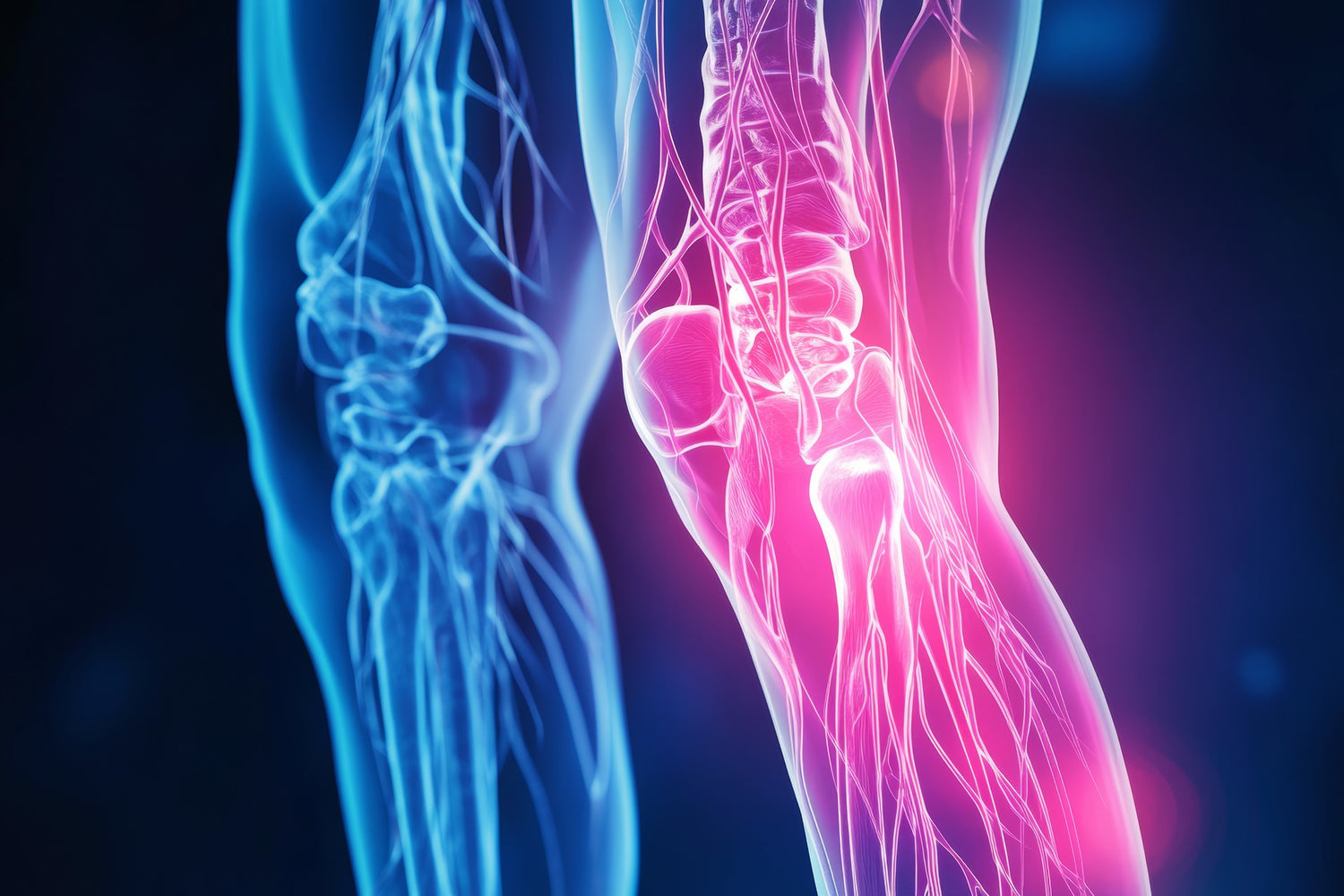At Rockbros, we believe in the transformative power of cycling. Whether you're an avid outdoor cyclist or prefer home-based indoor rides, cycling provides a wealth of benefits for your overall health, especially when it comes to protecting your joints. Unlike many high-impact activities, cycling is known for being gentle on your knees, hips, and ankles while offering a full-body workout that strengthens the muscles supporting these joints. In this blog post, we'll take a deep dive into how cycling can help protect your joints, the specific muscles it engages to support joint stability, and why indoor cycling is an excellent alternative for joint-conscious individuals.
Let’s explore how cycling can safeguard your joints and why it's a smart choice for maintaining long-term joint health, whether you're riding on the road or at home.
1. Cycling is a Low-Impact Exercise That Reduces Joint Strain

One of the most significant advantages of cycling is its low-impact nature. When you cycle, whether outdoors or on a stationary bike, your body avoids the jarring forces that are often experienced during activities like running, jumping, or high-intensity interval training (HIIT). Here's how:
-
Minimized Ground Impact: Unlike running, where every step creates impact force through your legs, knees, and hips, cycling involves smooth, fluid motions. Your body weight is supported by the bike, which reduces pressure on your weight-bearing joints.
-
Gentle on Cartilage: Cartilage serves as a cushion between your bones, and activities that apply excessive pressure can damage it over time, leading to joint issues like osteoarthritis. Cycling, on the other hand, helps you stay active without wearing down this vital joint tissue.
For people who are recovering from joint injuries or who already experience joint pain, this makes cycling an ideal exercise to stay active without the risk of further joint damage.
2. Cycling Strengthens Key Muscles That Support Joint Stability

While cycling is gentle on your joints, it works hard on your muscles. One of the keys to joint protection is having strong, balanced muscles around the joints. Strong muscles act like shock absorbers, stabilizing your joints and reducing the risk of injury or overuse damage. Let’s break down which muscles cycling engages and how that protects your joints:
-
Quadriceps (Thighs): The quads are the muscles at the front of your thighs, and they play a crucial role in stabilizing your knee joints. When you pedal, these muscles are heavily engaged, providing support to your knees and reducing the load on your knee joints.
-
Hamstrings (Back of Thighs): The hamstrings work alongside your quads to balance and stabilize the knee joint. Cycling targets both of these muscle groups, ensuring balanced strength in your legs, which is key to avoiding joint stress.
-
Gluteal Muscles (Buttocks): Your glutes are the largest muscles in your body and are vital for hip stability. Strong glutes help prevent excessive strain on the hips and lower back by maintaining proper alignment in your pelvic area as you ride.
-
Calf Muscles (Lower Leg): Your calves assist in stabilizing the ankles, which is essential for keeping your entire lower body in sync. By engaging your calves during cycling, you promote ankle health and reduce the risk of joint injuries in your lower extremities.
Cycling regularly helps you build muscle strength and endurance, which in turn lightens the load on your joints during everyday activities like walking, climbing stairs, or even sitting for long periods.
3. Cycling Promotes Joint Flexibility and Range of Motion
While building strength is crucial, flexibility and range of motion are just as important for joint health. Cycling encourages a natural range of motion in the knees, hips, and ankles, helping to maintain or even improve flexibility over time. Here’s how it works:
-
Controlled, Repetitive Motion: Cycling moves your joints in a continuous, controlled motion without sudden twists or impacts. This repetitive movement helps maintain flexibility, especially in the knees and hips, areas prone to stiffness and decreased range of motion as we age.
-
Lubricates Joints: Cycling also stimulates the production of synovial fluid, which lubricates your joints, reducing friction between cartilage and bones. This lubrication not only helps your joints move more smoothly but also protects them from long-term wear and tear.
Regular cycling can ease the stiffness many people feel, especially those dealing with arthritis or recovering from joint injuries, by promoting joint flexibility in a gentle and sustainable way.
4. Cycling for Arthritis Management: Safe and Effective
For people with arthritis, choosing the right form of exercise is critical. Cycling is often recommended by healthcare professionals because it provides the benefits of cardiovascular exercise without the high risk of aggravating joint pain. Here’s why cycling is particularly beneficial for arthritis sufferers:
-
Low Joint Impact: Because cycling doesn’t involve pounding the pavement, it’s easier on swollen or inflamed joints. People with arthritis can often cycle longer and with less discomfort than they would experience with other forms of exercise.
-
Helps Manage Symptoms: Regular cycling helps improve joint function by enhancing blood flow to the muscles and tissues around the joints. This increased circulation can reduce stiffness and pain associated with arthritis, leading to improved mobility and function.
-
Supports Weight Management: Maintaining a healthy weight is crucial for reducing pressure on joints, particularly in the knees. Cycling helps burn calories and manage weight without stressing the joints, making it an excellent choice for individuals aiming to reduce joint pain by shedding excess pounds.
5. Home Cycling: A Joint-Friendly, Accessible Option for All Fitness Levels

Image: Rockbros Foldable Bike Trainer Stand for Indoor Cycling - $199.99 - Shop
Cycling at home on a stationary bike offers all the joint-friendly benefits of outdoor cycling but with added convenience and safety. For people with joint concerns, setting up a home cycling routine can be a game-changer. Here’s why:
-
Customizable Workouts: Modern stationary bikes offer adjustable resistance settings, allowing you to control the intensity of your workout. For those with joint issues, starting with lower resistance and gradually increasing it can help build strength without overloading the joints.
-
Low-Risk Environment: Riding a stationary bike at home eliminates external risk factors like uneven terrain, potholes, or traffic, which can lead to falls or joint strain. You can focus entirely on your workout without worrying about external elements.
-
Joint-Friendly Warm-Up and Cool-Down: Stationary cycling allows you to control your pace and ensure a proper warm-up and cool-down, which are essential for preventing joint injuries. A slow start helps prepare your joints and muscles for more intense activity, while a gentle cool-down promotes recovery and flexibility.
-
Perfect for Any Weather: Unlike outdoor cycling, home cycling isn’t limited by weather or time of day. You can establish a consistent routine that protects your joints year-round without having to worry about environmental factors.
6. Maximizing Joint Protection While Cycling: Expert Tips
To make the most of your cycling workouts and ensure your joints are fully protected, follow these expert tips:
-
Bike Fit Matters: Proper bike setup is critical. Ensure your saddle height allows your knees to be slightly bent at the bottom of the pedal stroke. Incorrect saddle height can lead to knee strain. Similarly, handlebar positioning should allow for a natural, comfortable reach without straining your back or shoulders.
-
Start Slow and Build Gradually: If you're new to cycling or returning after an injury, start with shorter rides and low resistance. Gradually increase the duration and intensity to avoid putting too much stress on your joints too soon.
-
Stay Consistent: The key to long-term joint health is consistency. Aim to incorporate cycling into your routine several times a week. Regular exercise strengthens muscles, improves joint flexibility, and helps manage body weight, all of which contribute to healthier joints.
-
Stretch Regularly: After every ride, take the time to stretch your leg muscles, including your quadriceps, hamstrings, and calves. Flexibility training enhances joint mobility and helps prevent stiffness or soreness after workouts.
Conclusion
Cycling is an exceptional low-impact exercise that offers powerful benefits for joint health. Whether you ride outdoors or from the comfort of your home, cycling strengthens the muscles around your joints, improves flexibility, and helps manage conditions like arthritis—all without placing undue strain on your knees, hips, or ankles.
At Rockbros, we’re here to support your cycling journey with the right gear and advice, ensuring your rides are as comfortable and joint-friendly as possible. Explore our range of cycling products to enhance your ride and protect your joints today.







Leave a comment
This site is protected by hCaptcha and the hCaptcha Privacy Policy and Terms of Service apply.